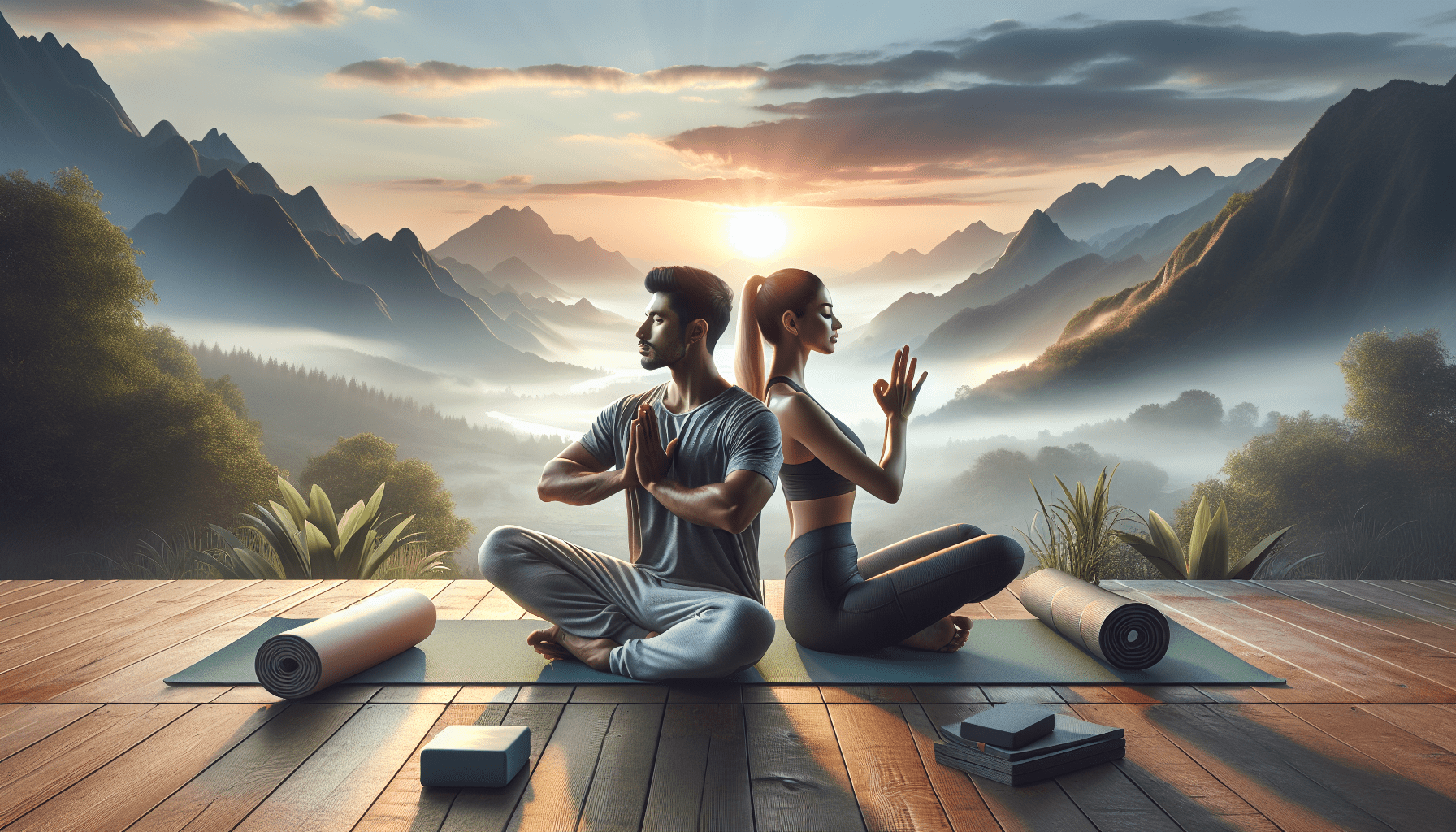If you’re new to yoga, it can feel like stepping into a whole new world with its own language. But fret not, as I’m here to help you navigate the intricacies of yoga terminology. As a yoga instructor specializing in working with beginners, I want to ensure that you feel comfortable and confident as you embark on this unique journey. In this article, we’ll explore a glossary of yoga terms so that you can understand and embrace the language that underpins this ever-evolving practice. From asanas to pranayama, we’ll unlock the secrets of yoga, making it accessible and enjoyable for all. So let’s dive in and unveil the secrets of the yoga realm together. Understanding Yoga Terminology: A Glossary for Beginners.
Asanas
Definition
Asanas are the physical postures practiced in yoga. They are designed to help increase flexibility, strength, and balance. Asanas are often referred to as yoga poses and are a fundamental part of any yoga practice.
Basic Poses
There are many different asanas that one can practice, but there are a few basic poses that are commonly taught to beginners. These include the Mountain Pose (Tadasana), the Warrior Pose (Virabhadrasana), and the Tree Pose (Vrksasana). These poses help to build a foundation for other more complex asanas.
Benefits
Practicing asanas has numerous benefits for both the body and mind. Physically, they help to improve flexibility, strength, and posture. Asanas also have a calming effect on the mind and can help reduce stress and anxiety. Regular practice of asanas can also improve digestion, boost the immune system, and promote overall well-being.
Pranayama
Definition
Pranayama refers to the practice of controlling the breath in yoga. It is derived from two Sanskrit words, “prana” meaning life force or vital energy and “ayama” meaning control or extension. Pranayama techniques are used to cultivate awareness, increase vitality, and channel energy throughout the body.
Breathing Techniques
There are various breathing techniques in pranayama, each with its own purpose and benefits. Some common techniques include the Full Yogic Breath, Alternate Nostril Breathing, and Breath of Fire. These techniques involve conscious control of inhalation, exhalation, and retention of breath.
Effects on Mind and Body
Pranayama has a profound effect on the mind and body. By regulating the breath, it helps to calm the mind, reduce stress and anxiety, and improve mental clarity. Physically, pranayama techniques help to purify and energize the body, improve lung function, and enhance overall respiratory health.
Chakras
Definition
Chakras are energy centers in the body that are often described as spinning wheels of energy. The word “chakra” is derived from Sanskrit and translates to “wheel” or “disk.” There are seven main chakras, each associated with a specific color, location, and energy.
Seven Main Chakras
The seven main chakras are the Root Chakra, Sacral Chakra, Solar Plexus Chakra, Heart Chakra, Throat Chakra, Third Eye Chakra, and Crown Chakra. Each chakra is believed to govern different aspects of our physical, mental, and emotional well-being. Balancing and opening the chakras is essential for overall harmony and vitality.
Balancing and Opening Chakras
There are various techniques to balance and open the chakras, including meditation, visualization, and specific yoga poses. Each chakra corresponds to different elements and qualities, and by working with them, we can restore balance and promote healing on all levels.
Meditation
Definition
Meditation is a practice that involves focusing the mind and achieving a state of relaxation and inner peace. It is a technique used to quiet the mind, cultivate mindfulness, and deepen self-awareness.
Different Techniques
There are various meditation techniques, including focused attention meditation, loving-kindness meditation, and transcendental meditation. Each technique has its own approach and benefits, but the underlying goal is to calm the mind and attain a state of deep relaxation.
Benefits for Beginners
Meditation has a multitude of benefits, especially for beginners. It can help reduce stress, anxiety, and depression, improve concentration and focus, and enhance overall well-being. Regular meditation practice can also improve sleep, increase self-awareness, and promote a sense of inner peace and happiness.
Mantras
Definition
Mantras are sacred sounds, words, or phrases repeated during meditation or chanting. They have a profound effect on the mind and body and are used to focus and quiet the mind.
Meaning and Purpose
Each mantra has its own meaning and purpose. For example, the popular mantra “Om” represents the sound of the universe and is often chanted to create a sense of unity and connection. Mantras are believed to have transformative and purifying effects on the mind, body, and soul.
Repeating Mantras
Repeating mantras is a powerful practice that can help calm and still the mind. The repetition of these sacred sounds or words creates a rhythmic vibration that can lead to a state of deep inner peace and spiritual awakening. Mantras can be repeated silently or aloud, and the more they are repeated, the more their effects are amplified.
Yoga Props
Definition
Yoga props are tools used to enhance and support the practice of yoga. They are designed to help practitioners of all levels improve alignment, flexibility, and strength.
Common Props
There are several common yoga props that you may come across in a yoga class. These include yoga blocks, straps, bolsters, blankets, and yoga wheels. Each prop serves a specific purpose and can be used to modify and deepen the practice of various asanas.
How to Use Props
Using yoga props is beneficial for practitioners of all levels, including beginners. Props can be used to provide stability and support, increase flexibility, and facilitate proper alignment. For example, a yoga block can be used to bring the ground closer to you in standing poses, while a strap can help you reach deeper into stretches. By using props, you can ensure a safe and effective practice.
Yoga Styles
Definition
Yoga has evolved into various styles, each with its own emphasis and approach. These styles cater to different needs and preferences and can be tailored towards specific goals or interests.
Hatha Yoga
Hatha yoga is a gentle and foundational style that focuses on physical postures (asanas) and breath control (pranayama). It is a great style for beginners as it provides a solid introduction to basic yoga principles and practices.
Vinyasa Yoga
Vinyasa yoga is a dynamic and flowing style that synchronizes movement with breath. It is often referred to as “flow” yoga and is known for its creative and seamless sequencing of poses. Vinyasa yoga is suitable for all levels and offers a more vigorous and cardiovascular practice.
Bikram Yoga
Bikram yoga, also known as hot yoga, is practiced in a heated room with specific sequences of 26 postures. The heat helps to increase flexibility and detoxify the body. Bikram yoga is a challenging and intense practice that can improve strength, flexibility, and endurance.
Iyengar Yoga
Iyengar yoga is known for its precision and attention to detail. It emphasizes proper alignment, the use of props, and holding poses for longer durations. Iyengar yoga is a great style for beginners who want to develop strength, flexibility, and stability.
Yoga Philosophy
Definition
Yoga philosophy encompasses the ancient teachings and principles that underpin the practice of yoga. It provides guidance on how to live a balanced and meaningful life and offers a framework for self-realization and spiritual growth.
Eight Limbs of Yoga
The Eight Limbs of Yoga, as outlined by the sage Patanjali in the Yoga Sutras, are a systematic approach to the practice of yoga. They consist of ethical principles (Yamas and Niyamas), physical postures (Asanas), breath control (Pranayama), withdrawal of the senses (Pratyahara), concentration (Dharana), meditation (Dhyana), and union with the divine (Samadhi).
Yamas and Niyamas
The Yamas and Niyamas are the ethical principles that govern a yogic lifestyle. The Yamas, which include non-violence, truthfulness, non-stealing, moderation, and non-possessiveness, guide our behavior towards others. The Niyamas, which include cleanliness, contentment, self-discipline, self-study, and surrender to a higher power, guide our behavior towards ourselves. Practicing the Yamas and Niyamas helps to cultivate virtues and create a harmonious and balanced life.
Savasana
Definition
Savasana, also known as Corpse Pose, is the final relaxation pose in a yoga practice. It is a posture of complete surrender and stillness, where the body is lying flat on the mat and the mind is relaxed and at peace.
Benefits
Savasana is a deeply restorative pose that allows the body and mind to integrate the benefits of the yoga practice. It promotes deep relaxation, reduces stress and anxiety, and rejuvenates the body and mind. Savasana is often considered the most important pose in yoga, as it allows for deep rest and restoration.
Relaxation Techniques
In Savasana, relaxation techniques such as deep breathing and visualization can be utilized to enhance the experience. Slow, conscious breathing can help calm the nervous system, while visualizing a peaceful and serene place can further deepen relaxation. By practicing these techniques in Savasana, you can ensure a truly rejuvenating experience.
Yoga Etiquette
Definition
Yoga etiquette refers to the guidelines and practices that help create a respectful and harmonious environment in a yoga class or studio. Following yoga etiquette ensures a positive and inclusive experience for all practitioners.
Respecting the Space
Respecting the space in a yoga class means being mindful of personal belongings, keeping the area clean and tidy, and avoiding unnecessary noise or distractions. It’s important to arrive on time, set up your mat in a considerate manner, and be aware of the space you are occupying.
Being Mindful of Others
Being mindful of others involves practicing good hygiene, maintaining a respectful and non-judgmental attitude, and being aware of your own impact on the class. It’s important to avoid strong scents, share the space with others, and refrain from speaking or distracting others during the practice. Being mindful of others creates a welcoming and supportive atmosphere for everyone.
In conclusion, understanding the various aspects of yoga, from asanas and pranayama to chakras and meditation, can provide a solid foundation for beginners. Exploring different yoga styles, incorporating the use of props, and embracing the philosophy of yoga can enhance both the physical and mental benefits of the practice. By respecting the space and being mindful of others, practitioners can create a harmonious and inclusive environment. So whether you’re a beginner or an experienced yogi, the world of yoga offers a vast array of practices and teachings to explore and delve deeper into the art of self-discovery and holistic well-being.







